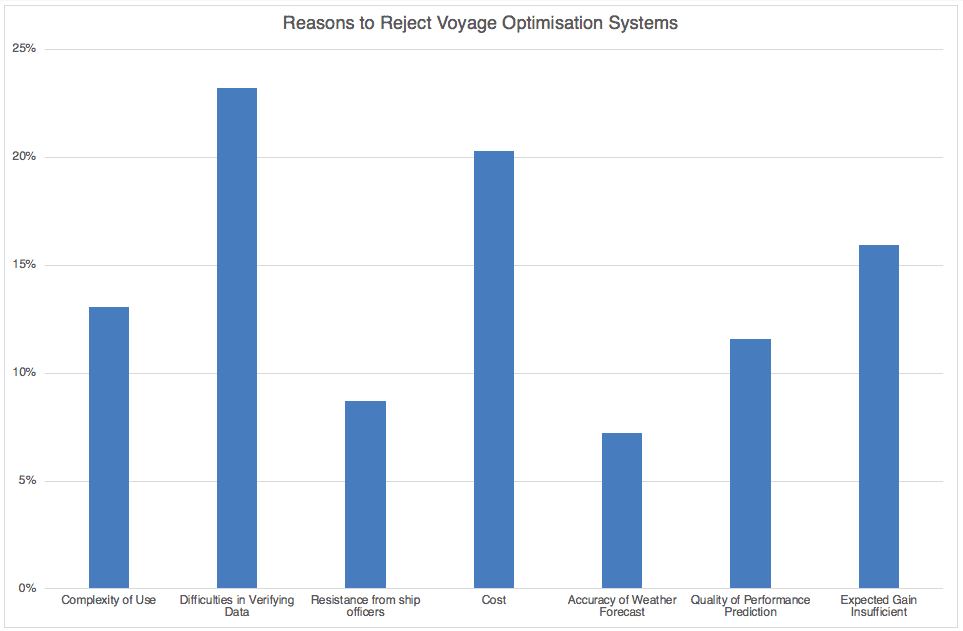Survey: Owners and charterers believe that voyage efficiency savings of 28% are possible
Research by digitalization veterans, NAPA, and BLUE Insight, shows optimism in the potential for savings that aligns with research into voyage optimization. However, cost and verification of data are still barriers to wider adoption.
Helsinki, Finland – 12 February 2020 – A survey has found that shipping sees a vast potential reduction in fuel consumption. Responding to a survey by NAPA and BLUE Insight, owners, managers, operators, and charterers felt that on average, it was possible to reduce 28% of their fuel consumption – a figure that that aligns with some recent studies on voyage optimization. The same respondents saw validation of data and cost as the biggest obstacles to their adoption of digital optimization solutions.

If you do not use voyage optimization systems, what are the biggest reasons? (Choose two most applicable)
While actual estimates of ship performance improvements vary widely, and depend heavily on vessel type, this estimate of potential performance improvements aligns with some recent studies. For example, a recent study by Miika-Matti Ahokas at Aalto University found that the potential for fuel saving and emission reduction from voyage optimization on mid-range tankers could be up to 28%, depending on the optimization strategy (in this case, a combination of just-in-time arrival and weather routing intended to optimize fuel efficiency).
For the shipowners, the consequential reduction in fuel cost would result in an approximately 17.8% increase in the average daily financial performance of the fleet (calculated in terms of Time Charter Equivalent – the difference between expenses and earnings over time).
However, economic incentives undermine much of the benefits that could be delivered by speed optimization.
“Digital voyage planning, and performance optimization solutions have been around for a long time, but as these estimates of improvement show, we’re currently a long way from getting the most out of our vessels. What’s interesting to see is that owners and operators recognize this, and their assessment of what’s possible isn’t too far away from what studies are finding,” commented Pekka Pakkanen, NAPA’s Director of Sales for Shipping Solutions.
“From the responses we’ve gathered, we can see that the main barrier to using these solutions is trust in the data that they use, and the reliability of voyage predictions,” he continued. “However, as these systems enter use, we’re beginning to grow our library of real-life use cases. Additionally, NAPA is improving our predictions with advanced hydrodynamic models that are based on years of real performance data, and the most advanced performance algorithms available, developed over the course of decades of using NAPA for ship design.
“Obviously the potential for voyage savings depends greatly on the optimization methods used and the nature of the vessel and voyage,” said Adrian Tolson, Director, and BLUE Insight Lead. “But it’s encouraging to see that owners and operators see such potential in voyage optimization solutions. At the same time, this also throws down the challenge to suppliers of digital solutions to prove that their systems deliver ROI, and demonstrate to owners how this works. This is likely to be one of the defining themes in the voyage optimization space this year.”
______________________________
[1] Analysis of voyage optimization benefits for different shipping stakeholders, Miika-Matti Ahokas, Aalto University, 2019
About NAPA
In its 30 years of operation, NAPA has become a global leader in software, services and data analysis for the maritime industry; providing best in class data-led solutions for safety, efficiency and productivity in both ship design and operations.
NAPA operates globally, with 10 offices across Asia, Europe and the Americas supported by its Helsinki headquarters. To date, NAPA has 420 user organizations for its design solutions and nearly 3,000 installations onboard vessels. For more information, visit www.napa.fi
Media enquiries
Georgia Bailey
BLUE Communications
T: +44 1865 514 214
E: georgia.bailey@blue-comms.com


